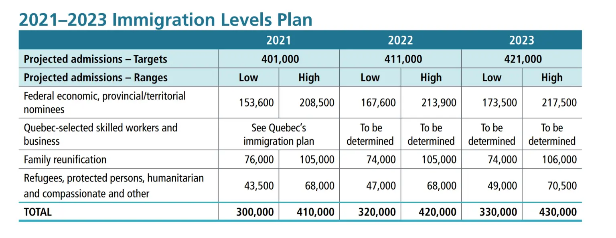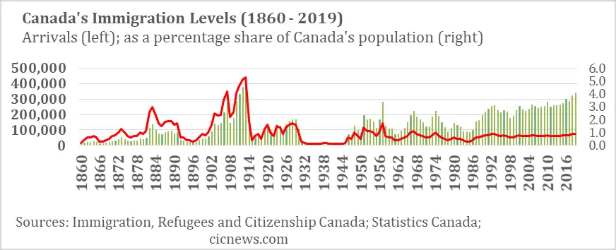Canada announced its 2021-2023 Immigration Levels Plan. Canada will target the highest level of immigration in its history for the first time since 1913. Canada will aim to welcome the following
level of new permanent residents:
• 2021: 401,000 immigrants
• 2022: 411,000 immigrants
• 2023: 421,000 immigrants
The only time Canada welcomed over 400,000 immigrants in a year was in 1913, when it admitted 401,000 newcomers. It has never come close to this figure again.
The 2021-2023 Immigration Levels Plan aims to welcome about 60 per cent of all immigrants under economic class programs, including through Express Entry and the Provincial Nominee Program.
Every year Canada welcomes immigrants under the following categories: economic; family; refugee; and humanitarian and compassionate grounds.

Earlier this year, on March 12, the federal government announced Canada would aim to welcome over one million new permanent residents between 2020 and 2022. Days later, Canada had to shut its borders due to the COVID-19 pandemic.
Due to pandemic Canada will likely fall well short of the 341,000 immigration target it set for this year, however it has been holding Express Entry draws throughout the pandemic that will result in Canada breaking its Express Entry record this year. In addition, Provincial Nominee Program (PNP) draws remain ongoing.
To compensate for the fall of immigration this year, Canada has set the most ambitious immigration levels plan in its history.
Canada is maintaining high levels of immigration to offset the negative economic and fiscal impacts of its aging population and low birth rate.
Canada has one of the world’s oldest populations, with nearly 18 per cent of its population being age 65 and over. It also has one of the world’s lowest birth rates at 1.47 births per woman. As such, Canada will face challenges growing its economy and supporting government spending in the future. These challenges can be be alleviated by welcoming more immigrants to support labour force and economic growth.
Canada’s immigration record was achieved in 1913 when it welcomed 401,000 immigrants which was over 5 per cent of its population in newcomers. Today, a 5 per cent newcomer intake would result in 2 million new immigrants arriving to Canada.

Canadian immigration during COVID-19
While admission targets are growing, Canada is experiencing a drop in the the number of new permanents landing in the country in 2020. There were 64 per cent fewer new permanent residents admitted in August, compared to August 2019. This is partially due to the number of people who were approved for permanent residence, but were unable to travel to Canada before their immigration documents expired due to coronavirus-related travel restrictions and other disruptions.
By a five-to-one margin, Canadians report that immigration makes Canada a better country, and they are more likely to say this is because it makes for a more diverse and multicultural place to live. Another survey by the Association of Canadian Studies found that Canadians generally see immigration as positive for long-term economic recovery, but they want to see family members given priority for immigration.




